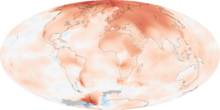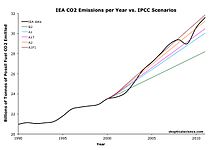For scientific and political disputes, see Global warming controversy, Scientific opinion on climate change and Public opinion on climate change.
For past climate change see Paleoclimatology and Geologic temperature record. For the Sonny Rollins album see Global Warming (album).
For past climate change see Paleoclimatology and Geologic temperature record. For the Sonny Rollins album see Global Warming (album).
Global mean land-ocean temperature change from 1880-2010, relative to the 1951-1980 mean. The black line is the annual mean and the red line is the 5-year running mean. The green bars show uncertainty estimates. Source: NASA GISS
The map shows the 10-year average (2000-2009) global mean temperature anomaly relative to the 1951-1980 mean. The largest temperature increases are in the Arctic and the Antarctic Peninsula. Source: NASA Earth Observatory[1]
Fossil fuel related CO2 emissions compared to five of IPCC's emissions scenarios. The dips are related to global recessions. Data from IPCC SRES scenarios; Data spreadsheet included with International Energy Agency's "CO2 Emissions from Fuel Combustion 2010 - Highlights"; and Supplemental IEA data. Image source: Skeptical Science
Global warming is the continuing rise in the average temperature of Earth's atmosphere and oceans. Global warming is caused by increased concentrations of greenhouse gases in the atmosphere, resulting from human activities such as deforestation and burning of fossil fuels.[2][3] This finding is recognized by the national science academies of all the major industrialized countries and is not disputed by any scientific body of national or international standing.[4][5][A]
The instrumental temperature record shows that the average global surface temperature increased by 0.74 °C(1.33 °F) during the 20th century.[6] Climate model projections are summarized in the Fourth Assessment Report (AR4) by the Intergovernmental Panel on Climate Change (IPCC). They indicate that during the 21st century the global surface temperature is likely to rise a further 1.5 to 1.9 °C (2.7 to 3.4 °F) for their lowest emissions scenario and 3.4 to 6.1 °C (6.1 to 11 °F) for their highest.[7] The ranges of these estimates arise from the use of models with differing sensitivity to greenhouse gas concentrations.[8][9]
An increase in global temperature will cause sea levels to rise and will change the amount and pattern of precipitation, and a probable expansion of subtropical deserts.[10] Warming is expected to be strongest in the Arctic and would be associated with continuing retreat of glaciers, permafrost and sea ice. Other likely effects of the warming include more frequent occurrence of extreme weather events including heatwaves, droughtsspecies extinctions due to shifting temperature regimes, and changes in agricultural yields. Warming and related changes will vary from region to region around the globe, though the nature of these regional changes is uncertain.[11] In a 4 °C world, the limits for human adaptation are likely to be exceeded in many parts of the world, while the limits for adaptation for natural systems would largely be exceeded throughout the world. Hence, the ecosystem services upon which human livelihoods depend would not be preserved.[12] and heavy rainfall events,
Proposed responses to global warming include mitigation to reduce emissions, adaptation to the effects of global warming, and geoengineering to remove greenhouse gases from the atmosphere or reflect incoming solar radiation back to space. The main international mitigation effort is the Kyoto Protocol, which seeks to stabilize greenhouse gas concentration to prevent a "dangerous anthropogenic interference".[13] As of May 2010, 192 states had ratified the protocol.[14] The only members of the UNFCCC that were asked to sign the treaty but have not yet ratified it are the USA and Afghanistan



Tidak ada komentar:
Posting Komentar